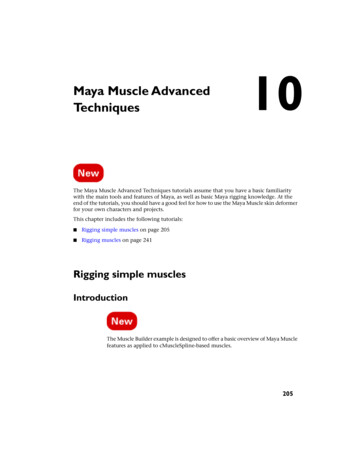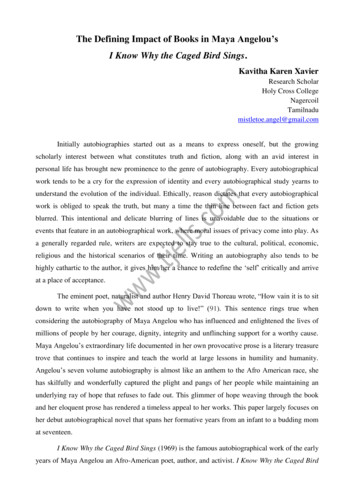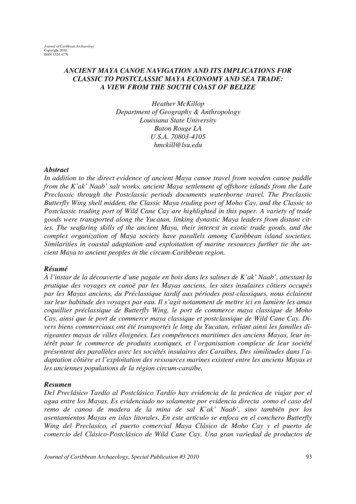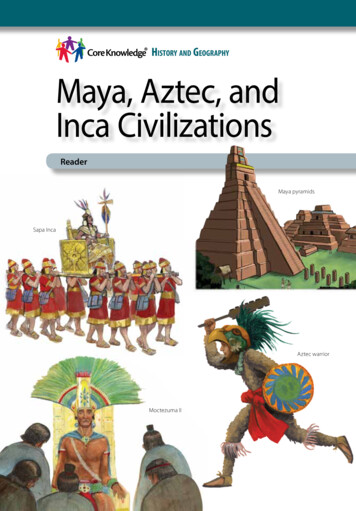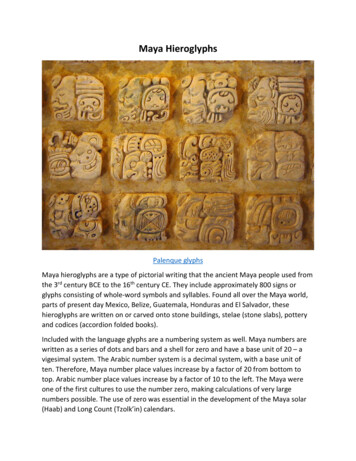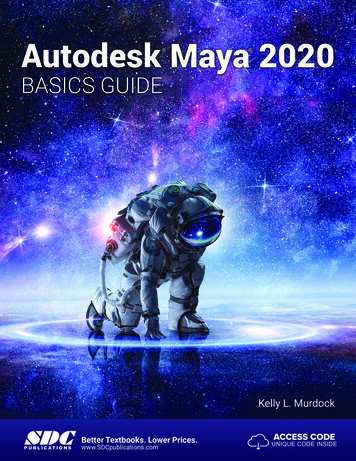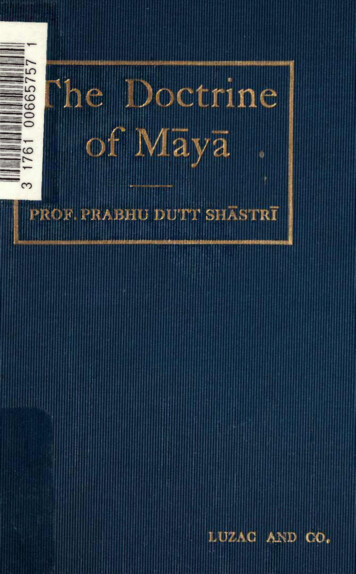
Transcription
Presentedto theLIBRARYof theUNIVERSITY OF TORONTObyPROFESSOR R. F. McRAE
THE DOCTRINE OF MAYA
THE DOCTRINE OFMAYAIn the Philosophy of the VedantaB7PRABHU DUTT SHASTRIPh.D.(Kiel},M.A., M.O.L., B.T. (Pb.\ B.Sc.Lit.Hum.(Oxon.), of Christ Church, Oxfordof India Research Scholar (Sanskrit-) ; Boden Research Grant,Oxford (1910); Theological Exhibitioner of Manchester College,Oxford; Member of the Oxford Philosophical Society; latelyAssociate of the Society for Psychical Research, London;GovernmentProfessor of Sanskrit, Oriental College, and First English Master and Lecturer in Psychology at theCollege, Lahore ; Inand Examiner of Rishikula,Hardwar ; etc., etc.Government TrainingspectorLONDONLUZAC AND CO(PUBLISHERS TO THE INDIA OFFICE)46,GREAT RUSSELL STREET, W.C1911
BUTLER & TANNER,THE SELWOOD PRINTING WORKS,FROME, AND LONDON.
PREFACETHEDoctrine of Maya is the pivotal principle inthe Advaita Philosophy the final pronouncementof Indian speculation on the conception of Realityand Appearance. During the last thirty years agood deal has been written on the Vedanta, andnaturally this doctrine has also been treated of,though only in passing and by the way. That it isrichly supported in the later Vedanta is alreadyan established fact, but a number of writers seemto conclude, rather hastily, that it is not the genuineproduct of the early speculation of the Upanisads,but has been later added to the original Vedantaby Sankara andhis followers.Somecritics believeimported from Buddhism and receiveshardly any countenance from the Upanisads. Thepoint is still debated, and it is only with a view tothatitiscontribute aonlittletowards a clearer understandingproblem that I undertook to examine theUpanisads as minutely and as fully as I could,thisalways relying upon the original texts more thanthemany morearetoor less slipshod translations whichHitherto these treatises havebe found.
PREFACEvibeenlooked upon as paradoxical, inconsistentand unsystematic. Scholars have only dashed atthem to get out some meaning, but have hardlyattempted to see if there existed in them an innerDeussen has, ofprinciple of unity and system.course, indicated in his Geschichte the evolution ofthought within the Upanisads, and has attemptedto base their chronology on such internal evidence.Working independently on theoriginal texts of thealsoreachedUpanisads,practically the sameconclusion, hence in Chapter II have enlarged andIhavedeveloped that scheme with the aid of all the moreimportant passages bearing on each point. Mymethod has been analytical, more appropriatelyI have not stated a factbutin every instance supportedhavedogmatically,it with appropriate references, an examination ofsynthetico-analyticwhich;will lead us inductively to the establishedToconclusion.view asthosewho do nothold the samea statement here and thereI,may appeardogmatic, but that hardly touches me, sinceI have kept out all questions of personal belief andhave only made an honest attempt to treat thealittlequestion scientifically. To press one s own personal belief and point of view in a scientific inquiryvitiates, I believe, the conclusions toisbe arrivedat.On the question whether the conception of Mayafound in the literature from Sankara down to thepresent day,investigatedallisThe point to beand to what extent the con-opinions concur.howfar
PREFACEviiception is to be traced in the earlier literature beforethe time of Sankara (who flourished about a thousand years beforeHencehauer).Ihis spiritual disciple,have confinedmySchopeninquiry to theVedic literature, especially the Upanisads, andhave carried my investigation down to Sankara.that the conception of Mayaas old as some of the later books of the RgvedaMyisconclusions arewhereits(i)forms are clearly noticeable, and thatitgradually developed through the speculation of theUpanisads, and passing through the hands ofGaudapada and Sankara was crystallized into atechnical form, elaborated more and more as timewent on;(2)""ofillusionthat the word"Maya,"of course, occurs laterin the sensefor the firstand10)startedhaveMaya(3)with gratuitously assuming Maya to be a concretetime in the Svetasvatara Upanisad(iv.;that most of the critics ofstanding face to face with the Absolute asreality,were, a tertium quid between the Absolute andthe Universe and this has made their whole critiitcismcisedfutileitandirrelevant.Some again havewhile perfectly ignoring one ofitscritichiefprinciples, which, expressed in modern KantianThe transcendental idealityphrase, would run":of theworld does not depriveitof its empiricalreality."Chapter I is more or less introductory, as it isintended to help indirectly towards a thoroughgrasp of the idea of Maya. The philology of the
PREFACETiiiword is not within the strict scope of my essay, butI have collected some suitable materials whichmayhelp to give an insight into the gradual transitionof meaning of the word itself.In Chapter II Ihave attempted to trace the development of theI do not, howconception, apart from the word.ever, claim that the internalsystem of the Upani-sads as sketched there, the transition of the variousstages of thought, etc., is to be looked upon as anultimate scheme or the only possible scheme. Butsurely it is one of the possible systematic ways oftreating the Upanisads, consistent andas far as it goes ; and as yet I know ofIn the same chaptercoherentno betterhave given a veryGaudapada Karikas on the Mandukya Upanisad, so far as they bear on the subject.This has its own justification, since the book isunfortunately not so well known, and even thosewho know it cursorily do not always understandscheme.brief analysis ofIsit correctly.Some of its epigrammatic stanzashave been erroneously construed so as to countenance either the doctrine of Sunyavada or that ofthe reality of the world. I have selected the mosttypical as well as the most difficult passages, which,I may hope, will remove doubts on this point.Itseems to me perfectly clear that Gaudapada wasa thoroughgoing idealist and a worthy precursorof Sankara.Then in Chapter III I have examinedbriefthefundamentalinobjections of the threeother schools within the Vedanta, especially those
ctions have never before been collected togetherand discussed in reference to the doctrine of MayaThe brevity in this part of the work wasproper.intended in order not to make the essay unnecesI had a mind, however, to appendsarily long.another chapter on the analogies of the Conceptionof Maya in European philosophy, especially in thesystems of Plato, Plotinus, Berkeley, Kant, andBut in the present volume I haveout, since it was felt that the present essayis in a way complete in itself, and that the additionalpart, which would have taken a considerable lengthSchopenhauer.left itinitself,isnot necessary for the purpose.I have given my own translation of passageswhich in my opinion have not been quite accuratelyrendered in the current translations.""have emIandployed the wordsappearancerather indiscriminately in translating""illusiontheword*though I am conscious of the subtledifference in the two conceptions.The word illusionhas been most current in this connexion. PersonTheally I would prefer the term appearance.maya,"world, says theMayatheory initscorrect interan appearance, not a mere illusion,pretation,since the latter as such is impossible.There aresome passages where the latter conception seems tobe held; e.g.,if rendered asamaydmatrammere illusionwould imply this. But as I haveis""""showninsomedetail with reference to passages
PREFACExfrom the Chandogya Upanisad,this was not exactlywhat was meant by the old Indian thinkers. Ihold that even if some of them really thought so,they were mistaken, and their ultra-rationalistictemper is to account for that. The Brhada-ranyaka Upanisad emphatically proclaims that theAtman is the only reality and that all plurality isa mere matter of wordsthe Chandogya Upanisad,;instead of starting with thethe world, and comes to theAtman, does so withsame conclusion fromthis standpoint as well, viz., that the worldisstrictlyspeaking the Atman itself, since there is no otherexistence but the Atman. These two positionscorrespond to Schopenhauer s parallel sayings(i) that the word is myVorstellung," (2) that:"it ismycausalityis theitMy"Wille."it isAslimitedbyan appearance, butspace, time,in itsandown natureAtman.best thanks are due to Professor Paul Deus-Rev. Dr. J. Estlin Carpenter, Professor A. A. Macdonell and Professor J. A. Smithsen(Kiel), theI am(Oxford), for their various useful suggestions.also grateful to Dr. F. H. Bradley, Dr. H. Rashdall,Dr. F. C. S. Schiller, Rev. L. P. Jacks (Oxford),Professor Henry Jones (Glasgow) and ProfessorRudolf Eucken (Jena), who were kind enough togive me opportunities to discuss with them thesubject of Maya in the light of European philosophyI havein order to remove some of my difficulties.also tothank Dr. F.W. Thomas,Librarian, India
PREFACEOffice,D.Barnett, of the Britishand the Librarians of the Bodleian forProfessorMuseum,xiL.their kind assistance withmanuscripts.Tobooks and unpublishedProfessor Barnett Iamfurtherobliged for correcting the proof sheets.PRABHU DUTT SHASTRI.CHRIST CHURCH, OXFORD,January, 1911.
CONTENTSPAGEPREFACE.CHAPTERHISTORY OF THEWORD"MAYAvI".1-32Introductory Bothlingk and Roth on MayaGeldnerUhlenbeckGrassmannMonierWilliams The Nighantu and the NiruktaConclusions so far The various forms of theword arranged in order of their frequency ofoccurrence References to R.V.Hymns ofR.V. where the word occurs Meaning of theword in R.V. Ludwig, Rosen Sayana sPower as Wittexplanations The idea ofdistinguished from that ofPhysical PowerRare occurrence of the word in Y. V. and S. V.,Reference to A.V. The Brahmanas The""""BSdaUpanisads Gaudapada s Karikasrayana s Sutras Sankara sBhsya Philosophical andPopular meanings Etymology Two-fold Conception of Maya Interconnexion of the various meanings.CHAPTERIIDEVELOPMENT OF THE CONCEPTION OF MAYA.Germsof the Idea in*R.V. x. 129, etc.SearchUnity The Brahmanas and the Upanisads Importance of the Brh. Up. Yajfiaval-afterxiii33-110
CONTENTSxivPAGEkya Idealism Metaphysical and EmpiricalAccommodationstandpoints Idea ofThe Upanisads as a system The stages ofs""PureIdealism,Pantheism, Cosmogonism,Theism and Materialism, etc. QuotationsinsupportDiscussion of the Idea in theBhagavadgita Gaudapada, andGeneral view of the modern waytationSankaraof interpreRecapitulation.CHAPTERIIIOBJECTIONS TO THE DOCTRINE WITHIN THEVEDANTA.The fourschools of the Vedanta -Their fundamental doctrine in relation to Maya Ramanuja s criticism of Maya Examination ofarguments Their chief fallacy Standpoint of Vallabha and Madhva Other moreimportant objections to the Theory Recapitulation Conclusion.his111-138
HISTORY OF THEWORD"MAYA"
CHAPTERHISTORY OF THE"MAYAwordsIf it"isIWORD"MAYA"one of the most important and prominentin thevocabulary of the Vedanta philosophy.had an unalterable andfixedmeaning throughout the history of Indian thought, our task wouldhave been lighter and we should have been saved thelabour of writing this chapter. But as it is, theword is very fluid, and has at different times assumedvarious shapes of meaning.Vedic literature seems atWhatitmeantin thesight to be almosttoitslaterOur bringinquiryconnectingbetweenfirstvarious meanings as they graduTo avoidally passed through stages of transition.all subsequent error and confusion in understandlinksitsing the conception of Maya, it seems necessary tomake clear the ground by first coming to termswith the worduse of wordshence,wefinishedifitself.isThe misconception and misat the root of a host of fallaciesbelieve thatno mean partweby meansare able,of our task;isof a careful philological research, to define the concept ofMayain
THE DOCTRINE OF MAYA4relationtoitshistoricaldevelopment.This willfurnish an insight into the Doctrine of Maya itself,which has always been a crux to the student ofof the word we shallandtrace the developmentproceed chronologically,of Sankara, whenthetimestoof its meaning downit acquired a rigid and technical sense, which survives even to-day.Bothlingk and Roth (in St. Petersburg DictionInphilosophy.treatingary] give the following differentword Kunst, ausserordentliches:meanings of theVermogen, Wun-derkraft, Kunstgriff, List, Anschlag, Trug, Gaukelei,kiinstlicheseinBlendwerk,Gebilde, Trugbild,NowTauschung.theirthese do not help us much byIn order to be free frommere juxtaposition.the fault of false analogy and hasty etymologizingand we now beginshall proceed inductivelyto view the meanings in connexion with the contextin which the word occurs.we;Geldnerwordasit*assigns the following meanings to theoccurs in the Rgveda and the A.V.(i):GestaltVerwandlung, angenommenesich und andere zu verwandeln,;dieKunst,Verzauberung,Zauberkraft, Zauberkunst, die Macht Wunder zu(2)tun, AllwissenheitBetrug, List, Schlauheitder(3)Illusion, Tauschung, Schein, Erdichtung;;;in das1Verborgene eindringende Geist, Phantasie.Karl F. Geldner, Der Rigveda in Auswahl, Stuttgart,1907.
HISTORY OF THE WORDUhlenbeck1takesalso5mean Wunderkraft,toitGrassmann"MAYA"2Trug, Trugbild.(after referring it tothe root ma man, vgl. mdti, Grk. ris) givesthe equivalentsiibermenschliche Weisheit oder:List, gottlicheKunst oder Zauber-Kunst, Zauber-bild, Trugbild.3Following Bohtlingk and Roth, Monier Williamsalso says that the meanings re onlyextraordinary or supernatural powerfound in the earlier languagebut when he adds:that in R.V. also"trick,"he"sornot accurate,Some shade ofisusing these words loosely.these is of course in R.V., and their further development is noticed in A.V., but to say that all theseisare found in R.V.isnot correct, but a hasty anderroneous generalization.The Nighantu, which is one of the earliest collechomonyms, mentionsmaya as4one of the eleven names of prajna(intelligence).The great commentator on the Nighantu, Yaska, 5"tions of Vedic"""1Uhlenbeck, Etymologisches Wdrterbuch der AltindischenSprache, Amsterdam, 189899.Grassmann, Wdrterbuch zum Rig-Veda.Monier Williams, Sanskrit-English Dictionary,edition, Clarendon Press, Oxford, 1899, p. 811.234Nighantu, vol.see p. 324, ch.iii.6iii.i.ofsec. 9.Bibl.Cf.Ind. ed.Roths ed.9 (p. 19).See The Nirukta, Bibl. Ind. ed., vol.new1882;Gottingen, 1852;Calcutta,ii.,published 1885,
THE DOCTRINE OF MAYA6same sense ofwhile exprajna1caratiplaining adhenvamayayaisah (Nir. i. 6, 4),imam u nu kavitamasya may am(Nir. vi. 3,32utu(Nir. vii. 7, 5),4),mayamyajniyanamandvisva hi may a avasi svadhavah(Nir. xii.4We shall have occasion to see presently2, 6)."brings out ;"mental commentary on R.V.meaning in his monuWithout citing anymoreus approach directlyhowfarSayanaofliststhe Sanskritsticks to thisletmeanings,and the Vedasliteraturefirstinorder to judge the meaning correctly from the usagein the context.After a careful examination of all the passageswhere the word occurs in any of its forms in thehuge bulk of R.V., we arrive at the following conclusions:As regards frequency of occurrence the formmost commonly met with is may ah 5 (nom. andi.ace. pi.).Nextinp. 134,1.10i.2081.;vol.iii.,published 1886,vol. iv., p. 278, 1. 10.Cf. Roth s ed. of Yaska sp. 190,1.2;p. 427,;13,no less than twenty-four times.order comes may ay a 6 (instr. sing.), whichIt occurs(p. 39).R.V."Nirukta"2Cf. Ibid. vi. 13 (p. 95-96).3Cf. Ibid. vii.*Cf. Ibid. xii.27176Cf.R.V.i.32.4,2.9,31.53. 8;v.Gottingen, 1852;x. 71. 5.(p. 124).(p. 174).117.7,R.V. v. 85. 6.R.V. x. S8. 6.R.V. vi. 58. i.3;40.6,ii.ii.40. 8;10, 27. 16 ; iii. 20.vi. 18. 9, 20. 4,22. 9, 44. 22, 45. 9, 58. i ; vii. I. 10, 98. 5, 99. 4 ; viii. 41. 8x. 53-9, 73- 5, 99- 2, in. 6.6Cf. R.V. i. 80. 7, 144. i, 160. 3 ; ii. 17. 5 ; iii. 27. 7;;
HISTORY OF THE WORDoccurs nineteen times(instr.thirteen timespi.),mdyl7mdyinam6(nom.occursalso7and gen.2mdydbhify;8mdyinam (ace.the word may a * itselfthe forms may am *of mdyin}, ten times ;oftimes, and eachsing.),(ace. pi.occurs fifteen timesof ng,three(ace.andmdyin},times.Mdyinl isand mdyindfound twice (R.V.v. 48. i ; x. 5. 3),ofsing,mdyin} only once (R.V. vi. 63. 5).(instr.Other forms, including compounds, which occurv. 48. 3), mdydvind (R.V.once are mdyini (R.V.x. 24. 4),mdydvdn (R.V. iv. 16. 9), mdydvinam (R.V.and mdydvinah (R.V. x. 83. 3).ii. 9),ii.There are altogether seventy-five hymns in2.R.V. in which the word appears incompounddressed to Indra21iv. 30. 12, 30.24viii.;of these thirty-five are adeight to Agni (R.V. i. 144 ;8;v. 63. 3, 63. 7;15, 41. 323.ix. 73. 5,;82. 3 ;2Cf.60.x.i;39. 2, 51. 5, 54. 4, 64.38. 7, 38. 9, 56. i ; v. 44. iiviii. 3. 19, 23. 14 ; x. 138. 3.R.V.147. 2.3Cf. R.V.6, 58. 2*66ii.i.;i.10,33.7,v. 30. 6, 44. 2, 78.6;51.;73. 9, 83. 3iii.;6vi. 22.;85. 18, 177. I.1Cf. R.V. i.ii. 10simple oritsOutforms.5,7,151.ii. 7, 53. 7, 56. 3, 80. 7 ;14 ; viii. 76. i ; x. 147. 2.vii.54139.ii.9;jiii.viii.n.104.x. 71. 5vi. 61. 3;vi. 47. 18, 63.;5ii.;;vii.6,34.14. 14;R.V. iii. 61. 7v. 63. 4x. 54. 2.R.V. v. 85. 5, 85. 6 x. 88. 6.Cf. R.V. vii. 28. 4x. 99. 10, 147. 5.Cf. R.V. i. 32. 4iii. 20. 3,34. 3.Vide R.V. i. n, 32, 33, 51, 53, 54, 56, 80, 144, 160;Cf.;;;7;8;v. 30.vi. 48.Cf.;;
THE DOCTRINE OF MAYA8v. 2vii. iviii. 23x. 5, 53)27to the Asvins (R.V. i. 117v. 78vi. 63as well as to the Maruts (R.V. i. 39, 64vi. 48)three to Visve-devah (R.V. iii. 56iii.20,;;;;;;;;;48)x. 24)v.Varuna (R.V.to(R.V.v.85viii.;Mitravarunau (R.V.ix. 73, 83),58;v. 44,;two each;Somafour;41),151i.;and Dyava-prthivyau (R.V. i. 100, 159) andone each to Usas (R.V. iii. 61), Sarasvati (R.V. vi.61), the Adityas (R.V. ii. 27), Pusan (R.V. vi. 58),v. 63),;RbhusSomarkauAtri (R.V. v. 40), Jfianam (R.V. x. 71), the60), Indravarunau (R.V.(R.V.(R.V. x. 85), Mayabheda (R.V. x. 177), Indravisnuvii. .38), and Surya-vaisvanarau (R.V. x. 88).3. The wordMaya is not employed in one andthe same sense throughout R.V. The Indian tra""dition itself bearsample testimony to this fact.As a rule, following Yaska, Sayana in most casesgives the meaning prajnd i.e., energy, mentalpower as distinguished from physical but he isin fact, he could not be so.not always definiteIt would be a gratuitous assumption on our partto expect the same word to be used in one and thesame rigid sense by so many different Rsis, whowere by no means all contemporary. Tradition;asii.preservedii, 1744, 45, 47138, 147.iii.;;in34, 53vii.;Sayanasiv. 16,3028, 98, 104;commentary;v. 30, 31viii. 3,14,76;;tellsusvi. 18, 20, 22,x. 73, 99,in,
HISTORY OF THE WORDand sometimes runmost common,land kapatathat the two meanings prajndinstance, even in the very firstc"MAYA"are theForparallel.hymn(R.V.i.n.7).which the word appears as mdyabhih (and mdyinam), Sayana seems to waver between these twomeanings, and leaves the reader to make his owninHe explains mdyabhih by kapatavisesaihbut addsby special stratagems, artificesat the same time that it may also meanprajWilsonnabhihby wondrous powers/ uot;by stratagems/ Ludmeaning,durch ubernatiirliche Kraft."translates it asadopts thewig2Rosen"first"3But these"also rendersitaspraestigiis."are not the only meanings acceptedIn R.V.tradition.by""mdyaydSayana explains4by knowledgeby karmavisaydbhijndnena," i.e.,This meaning appears to us toof sacred rites."hi.27.7"be rather far-fetched.the samewordIn R.V.as In60. ihe renders61. 7,iii.""mdyd"gloryin the form of effulgence or light.power,"prabhaIn R.V.Which mean artifice, deception, cunning.Germ. List,Betrug, Kunst, Kraft, etc.2Ludwig, Der Rigveda. Prag, 1878.3Fridericus Rosen, Rigveda-Samhita,Liber Primus,Sanskrite et Latine, London, 1838.4mimite jamteSayana derives this meaning thus1:karma miyate anayeti va maya karmavisayajnanam(rootma, to know), 3rd conj. mimite, or ma, to measure, miyate.5Sayana addsmiyante jfiayanta iti mayah karmani.Cf. also R.V. x. 53. 9, where Sayana saysKarmana:":maitat."
THE DOCTRINE OF MAYAo.v.and30. 21,themeaningv. 30. 6,Sayana emphatically givessakti (power).moment Mandalas i. andwhich are now supposed on good evidenceto have been subsequently added to the originalcollectionwe find the same want of fixity of themeaning conveyed by the term in the other books ofR.V. For instance, according to Sayana s traditionthe word is used in the sense ofin R.V.deceptionAgain, keeping aside for ax. ofR.V.""ii.ii. 10,iii.34. 6, iv. 16. 9, vi. 20. 4, vii. 104. 24,and so forth, while both the meanings "power"and deception" are taken in v. 30. 6 simultaneously.In v. 31. 7 the word is taken to meana young""This meaning too has its own justificanot unconnected with the other twowoman."tionandismeanings. In what sense a woman can be calledis not to be discussed here, but will find itsmaydappropriate place in the sequel.The two chief meanings, therefore, which theword is assigned in R.V. are power(Prajna, lit.andKapata/ Vanknowledgedeceptionthevarious pasTheaboveexaminationofcana).sages in which the word occurs has shown us thatwherever it means power the idea of mysteryi.e., it does not mean anynecessarily goes with t;""";"""a mysterious power of thewill" which we would translate into such SanskritInexpressions as sankalpa- sakti or icchd-sakti.R.V. iii. 53. 8, for instance, Indra is spoken of asphysicalpower, ot
HISTORY OF THEdone r but simply bywonderful and extraordinaryhis""(aneka-will-powerHe wills that he mayrupagrahanasamarthya)assume such and such forms and it is realizedhence Indra is very frequently termed mdyin in.;the Vedic hymns.results areand theseCertain mysterious things orproduced bythis mysterious will-power,results being wrfra-ordinary by their verybe said to set at naught the ordinarynaturemayhumanunderstanding, which because of its inherentdeceivedis apt to beby such pheno""limitationsHence, the idea ofmysterybeing comto both these meanings, it is quite easy tomena.mon"""understand the transition from the idea ofmys""to that ofInterious will-powerdeception."fact the two ideas interpenetrate each other, somuch so that it seems to us rather a forced distinction tomake when we speakdistinctions are to beof the transition.made, especiallyStill,when theyhelp us to a clearer understanding of that whichreallyWebeyond them.may, however, note herewhere Indra(cf.isespeciallyspokeniii.of as53. 8ispassing thatvariousformsassumingandinvi. 47.18)itappearsand Indians of theVedic age in general were not unaware of a distinction between the one and the many, of thepossibility of the one becoming the many and ofthat the singers of thehymnsthe latter being a deceptive creation of a mysteriouspower.
THE DOCTRINE OF MAYA12This inference seems to us to be reasonable andThe fact is very important, as we shall havethe opportunity to speak more of it later. Herevalid.we cannot do anything more than simply mentionit, since we are now concerned only with the meanings of the word so far as it can be determined bya collocation of ancient texts in a more or lesschronological order.Now, the word does not so often occur intheYajurveda and the Samaveda. This cannot surThese two Vedas containprise us in any way.themantrasthe Rgveda which areofmostlyandtosuittheir particular funcadaptedarrangedtionsIn the Y.V.as well as some new mantras.all ideas are subservient to sacrifice (yajfia) and itsvarious elaborate ceremonieswhile in the S.V.;chanting or singing the mantrasisThe R.V. is the chief sourcewhich along with it form whatof thesevidya,"i.e.,tripleabsence of the wordthe chief function.two Vedas,known as trayiThe comparative"isknowledge.Maya fromthe Y.V. and theS.V. does not affect our examination, as the R.V.can be safely taken to be an index to the ideas andviews of the ancient Indians of that age. It wasnot very long before these two Vedas sprang intoexistence, to beranked with the R.V. as to theirimportance and authorityin the tradition of theAryans. In fact these three Vedas seem to havebeen brought into existence almost simultaneously,thoughitmust be admitted thatittook a consider-
HISTORY OF THE WORD13"MAYA"ably long interval of time to give them the shapewhich they are found at present, i.e., as a completeinset of books.The Atharva-Veda was added to the trayl-vidydmuch later. The fact has been amply proved bya critical examination of both external and internalnot for us to enter into the questionThe A.V. represents a different state ofevidence.here.It issociety from that described in theare satisfied to note that the wordcivilization ofAnd weR.V.not missing in it. Altogether the wordoccurs in ten books only, in sixteen hymns 1 andMayaisin all (in A.V. viii. 9. 5 and viii. 10. 22word occurring twice in each of the hymns andtwice also in xiii. 2 and xix. 27).The form may a occurs only once (A.V. viii. 9. 5).The instrumental singular, may ay a, occurs mosttwenty timesthefrequently, viz., eightthree times and may dmtimes.42Mdyinah5and may ah3occurstwice each.Other forms which occur only once are mdye10. 22), may ay ah (viii. 9. 5), mdydbhih (xii.and may I1A.V.vii. 81. Ixiii.2.ii.;n.(v.iv. 23. 5, 38. 3 ; v. n. 4 ; vi. 72. I ;;24, 4. 24, 9. 5, 10. 22 ; x. 8. 34 ; xii. i. 8.ii ; xix. 27. 5,27. 6, 66. i, 68. i.29. 6viii. 3.3,2.sIndex VerborumWhitneytheAtharva-Veda, New-Haven,A.V. iv. 38. 3 ; vi. 72. i;8.8)4).Cf.2(viii.I.xiii. 2. 3, 2. iixix. 68.343A.V. xix. 27. 5, 27. 6, 66.1.4A.V. ii. 29. 6viii. 10. 22.6A.V. iv. 23. 5viii. 3. Text ofp.4.24225.;x.
THE DOCTRINE OF MAYA14Fromthe very nature of the contents of theAtharva-Veda it is easy to judge the meaning of theword mdydHere the mysterious orpowerspoken of in theRgveda is more emphasized, and there hardly seemsany scope for doubting the meaning. It meansmagicthroughout, and is even translated asillusion(the great controversial word in our1The two passages in whichsubject) by Whitney.it is rendered so are found in the well-knownMysas used inmagical element of uot;tichymn,extolling the Viraj, e.g., in A.V., 10. 22,Asuras called to her, O Illusion 2 (maya),comeIt may also be stated, by the way, thatA.V. vii. 81. i, viii. 3. 24, viii. 4. 24 are taken fromR.V. x. 85. 18, v. 2. 9, vii. 10. 4 respectively."The"!Now we have seen so far that mdyd in"R.V. meansan extra"a wondrous or supernatural power/supernaturalordinary skill," and that the""element is more strongly emphasized in A.V., whereit meansand henceillusion."magicWith regard to the word occurring in the Brahmanas it would be useless for us to enter into any"""Cf. Atharva-Veda Samhitd, trans, by W. D. Whitney(Harvard Oriental Series), 1905, vol. ii. p. 507, 514. Fortranslation see also Les Livres viii, et ix. de VAtharva Veda Traduits et Commentes, par Victor Henry, Paris,1894 ;and Griffith s The Hymns of the Atharva-Veda, andLudwig s Der Rigveda, Band iii., Einleitung, Prag,11878, p. 4932We woulduse of therather .instead ofWhitneys
HISTORY OF THE uot;15treatises,fundamental importance for our purpose, are the final portions of the Brahmanas, calledthe Upanisads.But before we take up the Upanisads proper, we may quote a few references fromwhich areofBrahmanas toothenydya.Thein formsthe436maya (xi. 69), mayam, mayaya and mayayam,and Mahidhara in his commentary gives the wordsand buddhi as synonyms of maya."prajnaThe Aitareya Brahmana 6 has mayaya (vi. 36),mayam, mayavant, and mayavattarah (viii. 23),where the word clearly meanssupernatural orThe formmayaya also quot;"skill."in the TaittiriyamaximBrahmana 7(iii.10. 8. 2)where,the cooking-pot and the boilingfinding one grain well-cooked we infer the samewith regard to all the others. So the conditions of the class1i.e.,rice."theof"Bybe inferred from that of a part, if the whole is made uphomogeneous and similar parts. Cf. Patanj all s MahaParyapto hi ekah pulakahbhasya, i. 4. 23 (Vart. 15).mayof"sthalyanidarsanaya."Weber, The White Yajurveda, part I, The VajasaneyiSamhita, in the Madhyandina and the Kanva-Sakha, withthe commentary of Mahidhara. Berlin and London, 1852.3V.S. xiii. 44. Mahidhara adds,Ibid., p. 420.miyatejndyate anaya iti maya,"2"*Ibid., p. 728, V.S. xxiii. 52.5Ibid., p. 841, V.S. xxx. 7.Das Aitareya Brahmana, herausgegeben von TheodorAufrecht, Bonn, 1879. See p. 184 and 230.7The Taittiriya Brahmana of the Black Yafurveda,8
THE DOCTRINE OF MAYA16asSayanaalso adds,meansit"by2. 4. 25), andmaye(iii.mayavant (xiii. 5. 4. 12) where the wordthe formsmeansdivine*Further the""mayam""The Paficaword mayaya (xiii.6. 9) in the same sense.Mayavant (as an adj
PREFACE THEDoctrine ofMaya is the pivotal principle in the Advaita Philosophy the final pronouncement ofIndian speculation ontheconception ofReality andAppearance. During the last thirty years a good deal has been written onthe Vedanta, and naturally this doctrine has also been treated of, though only inpassing andbytheway.That itis richly supported inthe later Vedanta is
